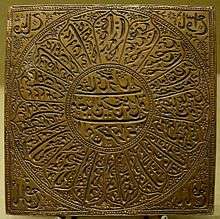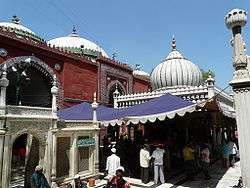Chishti Order
The Chishtī Order (Persian: چشتی chishtī) is a Sunni Sufi order within the mystic Sufi tradition of Islam. It began in Chisht, a small town near Herat, Afghanistan, about 930 CE. The Chishti Order is known for its emphasis on love, tolerance, and openness.[1] Chishti Sharif is name of village in Afghanistan near Iran border.

| Part of a series on |
| Sunni Islam |
|---|
 |
In terms of Ihsan |
|
|
|
Lists |
|
|
| Part of a series on Islam Sufism |
|---|
|
List of sufis |
|
|
The Chishti Order is primarily followed in Afghanistan and the Indian subcontinent, Pakistan and Bangladesh. It was the first of the four main Sufi orders (Chishti, Qadiri, Suhrawardi and Naqshbandi) to be established in this region. Khwaja Muinuddin Chishti introduced the Chishti Order in Ajmer (Rajasthan, India) sometime in the middle of the 12th century. He was eighth in the line of succession from the founder of the Chishti Order, Abu Ishaq Shami. There are now several branches of the order, which has been the most prominent South Asian Sufi brotherhood since the 12th century.[2]
In the last century, the order has spread outside Afghanistan and the Indian subcontinent. Chishti teachers have established centers in the United Kingdom, the United States, Australia, and Eastern and Southern Africa.
Guiding principles
The Chishti shaykhs have also stressed the importance of keeping a distance from worldly power.[3] A ruler could be a patron or a disciple, but he or she was always to be treated as just another devotee. A Chishti teacher should not attend the court or be involved in matters of state, as this will corrupt the soul with worldly matters. In his last discourse to his disciples, Khawaja Moinuddin Chishti said:
Never seek any help, charity, or favors from anybody except God. Never go to the courts of kings, but never refuse to bless and help the needy and the poor, the widow, and the orphan, if they come to your door.[4]

Chishti practice is also notable for Sama: evoking the divine presence by listening to and losing oneself in a form of music and poetry, most usually Qawwali.[5] The Chishti, as well as some other Sufi orders, believe that Sama can help devotees forget self in the love of Allah. However, the order also insists that followers observe the full range of Muslim obligations; it does not dismiss them as mere legalism, as some strands of Sufism have done.[5]
However some Qadiris point out that the Chisti Order and Moinuddin Chishti never permitted musical instruments, and cite a Chishti, Muhammad Ibn Mubarak Kirmani, the Mureed of Khwaja Fareed al-Deen Ganj-e-Shakar, who wrote in his Siyar al-Awliya that Nizamuddin Auliya said the following:[6]
“Sima’ (to listen to Qawwali) is permissible if a few conditions are met. The singer must be an adult and not a child or a female. The listener must only listen to everything in the remembrance of Allah. The words that are sung must be free from obscenity and indecency and they must not be void. Musical instruments must not be present in the gathering. If all these conditions are met, Sima’ is permissible.”
“...Someone complained to the Sultan of the Mashaa’ikh that some of the dervishes danced in a gathering where there were musical instruments. He said, they did not do good as something impermissible cannot be condoned.”
Furthermore, Nizamuddin Auliya said:[6]
Musical instruments are Haram.
Practices
The Chishtis follow five basic devotional practices (dhikr).[9]
- Reciting the names of Allāh loudly, sitting in the prescribed posture at prescribed times (dhikr-i jali)
- Reciting the names of Allāh silently (dhikr-i khafī)
- Regulating the breath (pās-i anfās)
- Absorption in mystic contemplation (murā-ḳāba)
- Forty days or more days of spiritual confinement in a lonely corner or cell for prayer and contemplation (čilla)
Literature
Early Chishti shaykhs adopted concepts and doctrines outlined in two influential Sufi texts: the ʿAwārif al-Maʿārif of Shaykh Shihāb al-Dīn Suhrawardī and the Kashf al-Maḥdjūb of Hudjwīrī. These texts are still read and respected today. Chishtis also read collections of the sayings, speeches, poems, and letters of the shaykhs. These collections, called malfūẓāt, were prepared by the shaykh's disciples.[10]
Spiritual lineage

Sufi orders trace their origins ultimately to the Islamic prophet Muhammad, who is believed to have instructed his successor in mystical teachings and practices in addition to the Qur'an or hidden within the Qur'an. Opinions differ as to this successor. Almost all Sufi orders trace their origins to 'Alī ibn Abī Ṭālib, Muhammad's cousin, whom the Shi'a regard as the first imam. The Chishti, though Sunni, trace their lineage through Ali. This is not unusual for Sufi orders, which tend to stress devotion rather than legalism and sectarianism.
The traditional silsila (spiritual lineage) of the Chishti order is as follows:[11]
- Muhammad
- Ali ibn Abu Talib
- Al-Ḥasan al-Baṣrī (d. 728, an early Persian Muslim theologian)
- 'Abdul Wāḥid Bin Zaid Abul Faḍl (d. 793, an early Sufi saint)
- Fuḍayl ibn 'Iyāḍ Bin Mas'ūd Bin Bishr al-Tamīmī
- Ibrāhīm bin Adham (a legendary early Sufi ascetic)
- Ḥudhayfa al-Marʿashī Basra Iraq
- Abu Hubayra al-Basri Basra Iraq
- Khwaja Mumshad Uluw Al Dīnawarī
- Abu Ishaq Shamī (d. 940, founder of the Chishti order proper)
- Abu Aḥmad Abdal Chishti
- Abu Muḥammad Chishti
- Abu Yusuf Nasar-ud-Din Chishtī
- Qutab-ud-Din Maudood Chishtī
- Haji Sharif Zindani (d. 1215)
- Usman Harooni (d. 1220)
- Mu'īnuddīn Chishtī (Moinuddin Chishti) (1141-1230 or 1142–1236)
- Qutab-ud-Din Bakhtyar Kaki (1173-1228)
- Farīduddīn Mas'ūd ("Baba Farid", 1173 or 1175 - 1266)
After Farīduddīn Mas'ūd, the Chishti order divided into two branches:
- Chishtī Sabri, who follow Alauddin Sabir Kaliyari (Sabiri/Sabriya branch)
- Chishtī Nizami who follow Nizāmuddīn Auliyā. (Nizami/Nizamiya branch)
History

The Encyclopedia of Islam divides Chishti history into four periods:
- Era of the great shaykhs (circa 597/1200 to 757/1356)
- Era of the provincial khānaḳāhs (8th/14th & 9th/15th centuries)
- Rise of the Ṣābiriyya branch (9th/15th century onwards)
- Revival of the Niẓāmiyya branch (12th/18th century onwards[12])
The order was founded by Abu Ishaq Shami ("the Syrian") who taught Sufism in the town of Chisht, some 95 miles east of Herat in present-day western Afghanistan.[13] Before returning to Syria, where he is now buried next to Ibn Arabi at Jabal Qasioun,[14] Shami initiated, trained and deputized the son of the local emir, Abu Ahmad Abdal.[15] Under the leadership of Abu Ahmad’s descendants, the Chishtiya, as they are also known, flourished as a regional mystical order.[14]
The founder of the Chishti Order in South Asia was Moinuddin Chishti. He was born in the province of Silistan in eastern Persia around 536 AH (1141 CE) into a sayyid family claiming descent from Muhammad.[16] When he was only nine, he memorized the Qur'an, thus becoming a hafiz. His father died when he was a teenager; Moinuddin inherited the family grinding mill and orchard. He sold everything and gave the proceeds to the poor. He traveled to Balkh and Samarkand, where he studied the Qur'an, hadith, and fiqh.[17] He looked for something beyond scholarship and law and studied under the Chishti shaykh Usman Harooni. He moved to Lahore and then to Ajmer, where he died. His tomb, in Ajmer, is the Dargah Sharif, a popular shrine and pilgrimage site.
Moinuddin was followed by Qutab-ud-Din Bakhtyar Kaki and Farīduddīn Mas'ūd 'Baba Farid'. After Fariduddin, the Chishti Order of South Asia split into two branches. Each branch was named after one of Fariduddin's successors:
- Nizamuddin Auliya - This branch became the Chishti Nizami branch.
- Alauddin Sabir Kaliyari - This branch became the Chishti-Sabiri branch.
It was after Nizamuddin Auliya that Chisti Sufism chain spread through far and wide throughout the Indian Peninsula. Two prominent lines of transmission arose from Nuizamuddin Auliya, one from his disciple Nasiruddin Chiragh Dehlavi and the other from another disciple, Akhi Siraj Aainae Hind, who migrated to West Bengal from Delhi on Nizamuddin Auliya's order. Siraj Aanae Hind was followed by his notable disciple Alaul Haq Pandavi settled in Pandava, West Bengal itself. From this chain of transmission another prominent sub-branch of Chishti way emerged known as Ashrafia Silsila after the illustrious saint Ashraf Jahangir Semnani, who was the disciple of Alaul Haq Pandavi in the thirteen century A.D. Later, yet other traditions branched from the Chisti lineage; in many cases they merged with other popular Sufi orders in South Asia.
As a result of this merging of the Chishti order with other branches, most Sufi masters now initiate their disciples in all the four major orders of South Asia: Chishti, Suhrawadi, Qadri, and Naqshbandi. They do however, teach devotional practices typical of the order with which they are primarily associated.
The Chishti order has also absorbed influences and merged at times with various antinomian fakir Sufi groups, especially the Qalandar. Some Chishtis both past and present have lived as renunciants or as wandering dervish.[18]
In more recent times, a more contemporary expression of traditional Chishti Sufi practices can be found in the establishment of the Ishq-Nuri Tariqa[19] in the 1960s, as a branch of the Chishti-Nizami silsila.[20]
In addition, a number of mixed-Sufi type groups or movements in Islam, have also been influenced by the Chishti Order proper.[21] The best known and most widespread example is of the Jamaat Ahle Sunnat, a Sunni Muslim sect with a huge international following, which is in essence not a proper Sufi organization though adopting many Sufi customs and traditions.[22]
Mughal rulers
Several rulers of the Mughal dynasty of South Asia were Chisti devotees. The emperor Akbar was perhaps the most fervent of them. It is said to be by the blessing of Shaikh Salim Chishti that Akbar's first surviving child, the future Jahangir, was born. The child was named Salim after the sheikh and was affectionately addressed by Akbar as Sheikhu Baba.
Akbar also credited the Chisti sheikhs with his victory at the Siege of Chittorgarh. Akbar had vowed to visit the Chisti dargah, the tomb of Moinuddin Chishti, at Ajmer if he were victorious. He fulfilled his vow by visiting the dargah with his musicians, who played in honor of the sheikh.
Shah Jahan's daughter, Jahanara Begum Sahib, was also a devout follower of the Chisti Order.
 The passing of Shah Jahan; attending him, his daughter Princess Jahanara.
The passing of Shah Jahan; attending him, his daughter Princess Jahanara. The Mughal Emperor Akbar was a great patron of the Chishti Order.
The Mughal Emperor Akbar was a great patron of the Chishti Order.
Other notable Chishti shaykhs
- Qutb ud deen Modood Chishti 527 A.H
- Haji Shareef zandani 612 A.H
- Usman Harooni 617 A.H
- Qut ul aqtab Qutb ud deen Bakhtiyar kaki 635 A.H (Delhi, India)
- Fareed ud deen Mas’ood Ganj E Shakar 668 A.H (Pak Patan Sharif, Pakistan)
- Naseer ud deen Mahmood Charagh Dehlavi 757 A.H (Delhi, India)
- Syed jalaluddin husain naqvi al Bukhari famous as Makhdoom jahanian jahangasht, uch sharif ( 1308 - 1384 AD ) Tajuddin Chishti (Chishtian Sharif, Pakistan)
- Amir Khusro (Delhi, India)
- Akhi Siraj Aainae Hind (Dist. Malda, West Bengal, India)
- Alaul Haq Pandavi (Dist. Malda, West Bengal, India)
- Ashraf Jahangir Semnani[23] (Kichaucha, Uttar Pradesh, India)
- Burhanuddin Gharib (Maharashtra, India)
- Bande Nawaz (Gulbarga, India)
- Salim Chishti (Fatehpur Sikri, India)
- Noor Muhammad Maharvi1205 A.H (Mahar Sharif, Pakistan)
- Muhammad Suleman Taunsvi 1267 A.H (Taunsa Sharif, Pakistan)
- Ata Hussain Fani Chishti (Bihar, India)
- Khwaja Ghulam Farid (Mithankot, Pakistan)
- Muhammad Shamsuddin Sialvi 1300 A.H (Sial Sharif, Pakistan)
- Ahamed Mohiyudheen Noorishah Jeelani (Noori Maskan, Hyderabad)[24]
- Meher Ali Shah (Golra Sharif, Pakistan)[25]
- Inayat Khan (Vadodara, Gujarat)
- Fariduddin Tavaela Bukhsh (Bihar, India)
- Haji Imdadullah Muhajir Makki (Muzaffarnagar, India/Makkah, Saudi Arabia)
- Sheikh Maulana Badruddin Chishti Hussaini Rh 1340 A.H (Pen, Raigadh, Maharashtra, India)
- Astana Chishtiya Multani Baba, Gangwar Shareef (Medak district, Telangana)
- Syed Sharfuddin Shah Wilayat Naqvi (Amroha)
See also
Notes
- Ernst, Carl W. and Lawrence, Bruce B. (2002) Sufi Martyrs of Love: The Chishti Order in South Asia and Beyond Palgrave Macmillan, New Yorks 1234567 4039-6026-7
- Rozehnal, Robert. Islamic Sufism Unbound: Politics and Piety in Twenty-First Century Pakistan. Palgrave MacMillan, 2007. Print.
- Sufi martyrs of love By Carl W. Ernst, Bruce B. Lawrence, p. 4.
- Chishti, Hakim Moinuddin (1991). The Book of Sufi Healing. Rochester: Inner Traditions International. ISBN 0-89281-324-5.
- Sufi martyrs of love By Carl W. Ernst, Bruce B. Lawrence, p. 5.
- Hussain, Zahid (22 April 2012). "Is it permissible to listen to Qawwali?". TheSunniWay. Retrieved 12 June 2020.
- Muhammad bin Mubarak Kirmani. Siyar-ul-Auliya: History of Chishti Silsila (in Urdu). Translated by Ghulam Ahmed Biryan. Lahore: Mushtaq Book Corner.
- Nizamuddin Auliya (31 December 1996). Fawa'id al-Fu'aad: Spirtual and Literal Discourses. Translated by Z. H. Faruqi. D.K. Print World Ltd. ISBN 9788124600429.
- Nizami, K.A. -0141 "Čishtiyya." Encyclopaedia of Islam, Second Edition. Edited by: P. Bearman, Th. Bianquis, C. E. Bosworth, E. van Donzel, and W. P. Heinrichs. Brill, 2011. Brill Online. Augustana. 6 April 2011.
- Böwering, Gerhard. "Cestiya." Encyclopaedia Iranica. Online Edition. Vol. 5. 1992. Web. <http://www.iranica.com/articles/cestiya>.
- Muhammad Zakariya Kandhalvi. Mashaikh-e-Chisht. Trans. Majlisul Ulama of South Africa., available at Scribd
- Nizami, K.A. "Čishtiyya." Encyclopaedia of Islam, Second Edition. Edited by: P. Bearman, Th. Bianquis, C. E. Bosworth, E. van Donzel, and W. P. Heinrichs. Brill, 2011. Brill Online. Augustana. 6 April 2011 <http://www.brillonline.nl/subscriber/entry?entry=islam_COM -0141>.
- ORIGIN OF CHISHTIES Archived 27 August 2010 at the Wayback Machine. Retrieved August 15, 2008.
- The Sufis of Britain: an exploration of Muslim identity By Ron Geaves. Cardiff Academic Press, 2000, p. 87.
- Encyclopaedia of Indian philosophy, Volume 2 By Vraj Kumar Pandey. Anmol Publications, 2007, p. 78.
- Nizami, K.A. "Čishtī, Ḵhwādja Muʿīn al-Dīn Ḥasan." Encyclopaedia of Islam, Second Edition. Edited by: P. Bearman, Th. Bianquis, C. E. Bosworth, E. van Donzel, and W. P. Heinrichs. Brill, 2011. Brill Online. Augustana. 6 April 2011 <http://www.brillonline.nl /subscriber/entry?entry=islam_SIM-1623>.
- Haeri, Muneera. The Chishtis: A Living Light. Oxford University Press, USA, 2000. Print.
- Frembgen, Jurgin Wasim. Journey to God: Sufis and Dervishes in Islam. Oxford University Press, USA, 2008, pp. 94-95. ISBN 978-0-19-547642-2.
- Popular in South Asia, in particular parts of Pakistan, India and Bangladesh. See Dr Annemarie Schimmel, in article 'The Chishti Sufis of South Asia--Tradition and Evolution in the 20th Century' in Anderoon: Sufi Journal, Vol 82, np, nd
- Schimmel, as cited above
- Dr M Z Akhund 'Sufis in the Subcontinent and their impact on Islamic society' Lahore, Navratna Pubs, Urdu Bazar, 1957. pp 12, 109-115
- Akhund, 114-115
-
- Hayate Makhdoom Syed Ashraf Jahangir Semnani(1975) Second Edition (2017) ISBN 978-93-85295-54-6, Maktaba Jamia Ltd, Shamshad Market, Aligarh 202002, India
- Ahamed Mohiyudheen Noorishah Jeelani
- Omer Tarin article in 'Muse India' journal online. Special Sufi literature feature,V. No73, May–June 2017]
References
- Haeri, Muneera (2000) The Chishtis: a living light Oxford University Press, Oxford, UK, ISBN 0-19-579327-7
- Ernst, Carl W. and Lawrence, Bruce B. (2002) Sufi Martyrs of Love: The Chishti Order in South Asia and Beyond Palgrave Macmillan, New York, ISBN 1-4039-6026-7. Excerpts
- Farīdī, Iḥtishāmuddīn (1992) Tārīk̲h̲-i iblāg̲h̲-i Cisht Āl Inḍiyā Baz-i Ḥanafī, Delhi, OCLC 29752219 in Urdu with biographies
- Āryā, Ghulām ‘Alī (2004) Ṭarīqah-i Chishtīyah dar Hind va Pākistān: ta’līf-i Ghulām‘alī Āryā Zavvār, Tehran, ISBN 964-401-200-3 in Persian
- Chopra, R.M., "SUFISM", 2016, Anuradha Prakashan, New Delhi. ISBN 978-93-85083-52-5.